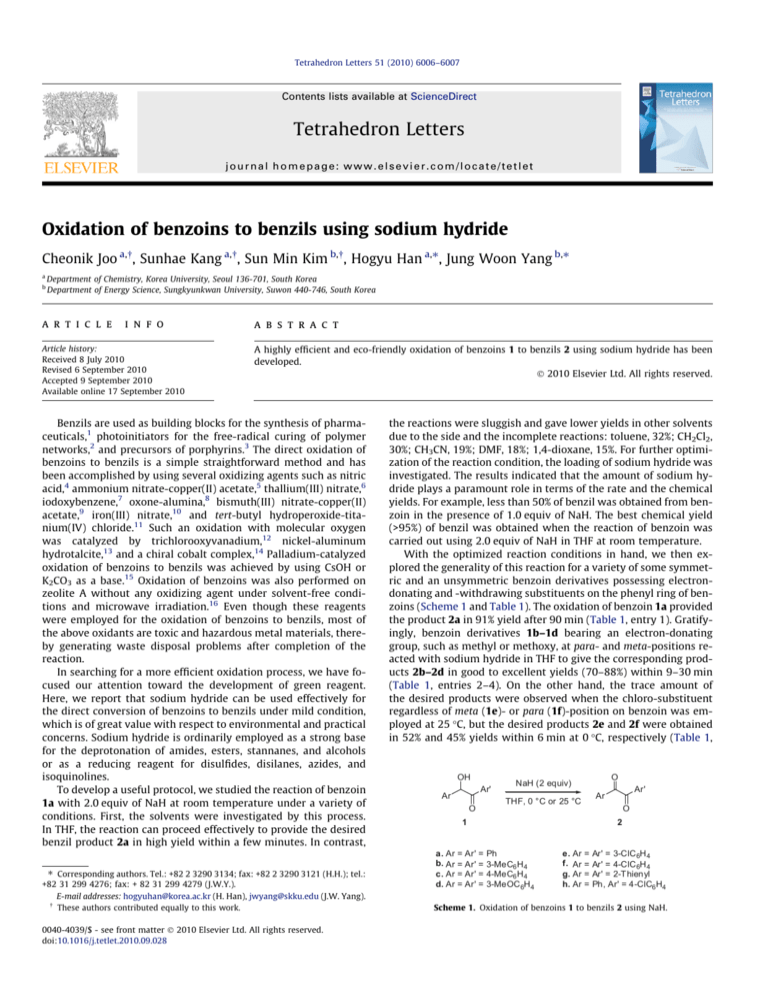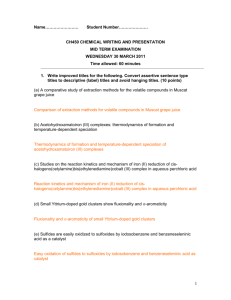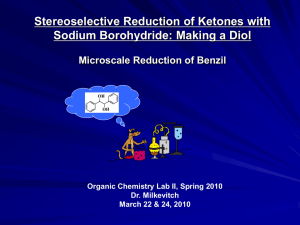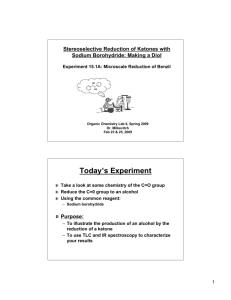
Tetrahedron Letters 51 (2010) 6006–6007
Contents lists available at ScienceDirect
Tetrahedron Letters
journal homepage: www.elsevier.com/locate/tetlet
Oxidation of benzoins to benzils using sodium hydride
Cheonik Joo a,!, Sunhae Kang a,!, Sun Min Kim b,!, Hogyu Han a,⇑, Jung Woon Yang b,⇑
a
b
Department of Chemistry, Korea University, Seoul 136-701, South Korea
Department of Energy Science, Sungkyunkwan University, Suwon 440-746, South Korea
a r t i c l e
i n f o
Article history:
Received 8 July 2010
Revised 6 September 2010
Accepted 9 September 2010
Available online 17 September 2010
a b s t r a c t
A highly efficient and eco-friendly oxidation of benzoins 1 to benzils 2 using sodium hydride has been
developed.
! 2010 Elsevier Ltd. All rights reserved.
Benzils are used as building blocks for the synthesis of pharmaceuticals,1 photoinitiators for the free-radical curing of polymer
networks,2 and precursors of porphyrins.3 The direct oxidation of
benzoins to benzils is a simple straightforward method and has
been accomplished by using several oxidizing agents such as nitric
acid,4 ammonium nitrate-copper(II) acetate,5 thallium(III) nitrate,6
iodoxybenzene,7 oxone-alumina,8 bismuth(III) nitrate-copper(II)
acetate,9 iron(III) nitrate,10 and tert-butyl hydroperoxide-titanium(IV) chloride.11 Such an oxidation with molecular oxygen
was catalyzed by trichlorooxyvanadium,12 nickel-aluminum
hydrotalcite,13 and a chiral cobalt complex,14 Palladium-catalyzed
oxidation of benzoins to benzils was achieved by using CsOH or
K2CO3 as a base.15 Oxidation of benzoins was also performed on
zeolite A without any oxidizing agent under solvent-free conditions and microwave irradiation.16 Even though these reagents
were employed for the oxidation of benzoins to benzils, most of
the above oxidants are toxic and hazardous metal materials, thereby generating waste disposal problems after completion of the
reaction.
In searching for a more efficient oxidation process, we have focused our attention toward the development of green reagent.
Here, we report that sodium hydride can be used effectively for
the direct conversion of benzoins to benzils under mild condition,
which is of great value with respect to environmental and practical
concerns. Sodium hydride is ordinarily employed as a strong base
for the deprotonation of amides, esters, stannanes, and alcohols
or as a reducing reagent for disulfides, disilanes, azides, and
isoquinolines.
To develop a useful protocol, we studied the reaction of benzoin
1a with 2.0 equiv of NaH at room temperature under a variety of
conditions. First, the solvents were investigated by this process.
In THF, the reaction can proceed effectively to provide the desired
benzil product 2a in high yield within a few minutes. In contrast,
⇑ Corresponding authors. Tel.: +82 2 3290 3134; fax: +82 2 3290 3121 (H.H.); tel.:
+82 31 299 4276; fax: + 82 31 299 4279 (J.W.Y.).
E-mail addresses: hogyuhan@korea.ac.kr (H. Han), jwyang@skku.edu (J.W. Yang).
!
These authors contributed equally to this work.
0040-4039/$ - see front matter ! 2010 Elsevier Ltd. All rights reserved.
doi:10.1016/j.tetlet.2010.09.028
the reactions were sluggish and gave lower yields in other solvents
due to the side and the incomplete reactions: toluene, 32%; CH2Cl2,
30%; CH3CN, 19%; DMF, 18%; 1,4-dioxane, 15%. For further optimization of the reaction condition, the loading of sodium hydride was
investigated. The results indicated that the amount of sodium hydride plays a paramount role in terms of the rate and the chemical
yields. For example, less than 50% of benzil was obtained from benzoin in the presence of 1.0 equiv of NaH. The best chemical yield
(>95%) of benzil was obtained when the reaction of benzoin was
carried out using 2.0 equiv of NaH in THF at room temperature.
With the optimized reaction conditions in hand, we then explored the generality of this reaction for a variety of some symmetric and an unsymmetric benzoin derivatives possessing electrondonating and -withdrawing substituents on the phenyl ring of benzoins (Scheme 1 and Table 1). The oxidation of benzoin 1a provided
the product 2a in 91% yield after 90 min (Table 1, entry 1). Gratifyingly, benzoin derivatives 1b–1d bearing an electron-donating
group, such as methyl or methoxy, at para- and meta-positions reacted with sodium hydride in THF to give the corresponding products 2b–2d in good to excellent yields (70–88%) within 9–30 min
(Table 1, entries 2–4). On the other hand, the trace amount of
the desired products were observed when the chloro-substituent
regardless of meta (1e)- or para (1f)-position on benzoin was employed at 25 "C, but the desired products 2e and 2f were obtained
in 52% and 45% yields within 6 min at 0 "C, respectively (Table 1,
OH
Ar'
Ar
O
THF, 0 °C or 25 °C
1
a. Ar = Ar' =
b. Ar = Ar' =
c. Ar = Ar' =
d. Ar = Ar' =
O
NaH (2 equiv)
Ar'
Ar
O
2
Ph
3-MeC6 H 4
4-MeC6 H 4
3-MeOC 6H 4
e. Ar =
f. Ar =
g. Ar =
h. Ar =
Ar' = 3-ClC 6H 4
Ar' = 4-ClC 6H 4
Ar' = 2-Thienyl
Ph, Ar' = 4-ClC6 H4
Scheme 1. Oxidation of benzoins 1 to benzils 2 using NaH.
C. Joo et al. / Tetrahedron Letters 51 (2010) 6006–6007
Table 1
Oxidation of benzoins 1 to benzils 2 using NaH
a
b
c
d
Entry
Substratea
Productb
Temp ("C)
Time (min)
Yieldc (%)
1
2
3
4
5
6
7
8
9
10
1a
1b
1c
1d
1e
1e
1f
1f
1g
1h
2a
2b
2c
2d
2e
2e
2f
2f
2g
2h
25
25
25
25
25
0
25
0
25
25
90
15
30
9
15
6
10
6
15
6
91
80
88
70
5d
52
5d
45
90
86
Substrates 1b, 1d–1f were prepared and characterized as described.17
Products 2 were obtained and characterized as described.18
Isolated yield.
TLC yield.
OH
O
Ar'
Ar
Ar'
Ar
O
O
1
2
NaH
(1 equiv)
Na O
Ar
Ar'
H
O
O2
2 Na2 CO 3 + 2 H2 O
HO2
NaH
(1 equiv)
2 NaHCO3
2 NaOH
4
3
Figure 1. Proposed mechanism for the oxidation of benzoins 1 to benzils 2 using
NaH.
entries 5–8). Treating the heteroatom-containing benzoin derivative 1g and the unsymmetric benzoin derivative 1h with sodium
hydride in THF gave the corresponding products 2g and 2h in
90% and 86% yields within 15 and 6 min, respectively (Table 1, entries 9 and 10).
To elucidate the role of oxygen in this process, we conducted
the reaction of benzoin 1a with sodium hydride in oxygen-free
THF, which was introduced by vacuum transfer at !78 "C. As a result, the moderate conversion (58%) was gained under this condition. It may seem obvious that oxygen plays an important role in
the oxidation of benzoins.
The most important parameter influencing chemical yield in the
reaction course is the controlled reaction time. It is noteworthy
that the color change of the reaction mixture from navy solutions
to yellow solutions represented the starting point of by-product
formation. Another point is that the basic work-up (aqueous NaHCO3) was required to obtain high yield of the benzils after completion of the reaction.
The proposed mechanism for the sodium hydride-mediated oxidation of benzoins 1 to benzils 2 is illustrated in Figure 1. In the
first step, 1 equiv of NaH leads to complete deprotonation of the
hydroxyl group in the benzoins 1. In the second step, a-hydride
of the resulting intermediate 3 is presumably transferred to molecular oxygen, leading to transient formation of hydroperoxide 4 and
thus, simultaneously providing the desired benzil products 2.15b
Although the resulting hydroperoxide is not extremely reactive toward benzions, however, it may potentially react with an additional equiv of NaH. Subsequently, 2 equiv of NaOH is released
into the solution and then, it can be almost neutralized by 2 equiv
of aqueous NaHCO3 added for work-up, thereby producing the desired product without any by-products.
6007
In conclusion, we conducted a facile and simple method for the
oxidation of benzoins to benzils using sodium hydride in good to
excellent yields. Further studies of other related applications of this
protocol are currently ongoing in our laboratories.
Acknowledgments
This work supported by the NRF grant (No. 2009-0075000) to
H.H. and the NRF WCU program (R31-2008-000-10029-0) to J.W.Y.
References and notes
1. (a) Li, J. J.; Norton, M. B.; Reinhard, E. J.; Anderson, G. D.; Gregory, S. A.; Isakson,
P. C.; Koboldt, C. M.; Masferrer, J. L.; Perkins, W. E.; Seibert, K.; Zhang, Y.;
Zweifel, B. S.; Reitz, D. B. J. Med. Chem. 1996, 39, 1846–1856; (b) Campillo, N.;
García, C.; Goya, P.; Páez, J. A.; Carrasco, E.; Grau, M. J. Med. Chem. 1999, 42,
1698–1704; (c) Muccioli, G. G.; Martin, D.; Scriba, G. K. E.; Poppitz, W.;
Poupaert, J. H.; Wouters, J.; Lambert, D. M. J. Med. Chem. 2005, 48, 2509–2517;
(d) Singh, D. P.; Kumar, R.; Singh, J. Eur. J. Med. Chem. 2009, 44, 1731–1736.
2. (a) Yu, D. H.-S.; Torkelson, J. M. Macromolecules 1988, 21, 852–853; (b) Catalina,
F.; Peinado, C.; Blanco, M.; Alonso, A.; Allen, N. S. J. Photochem. Photobiol. A:
Chem. 2000, 131, 141–146; (c) Roy, P. K.; Surekha, P.; Rajagopal, C.; Chatterjee,
S. N.; Choudhary, V. Polym. Degrad. Stab. 2005, 90, 577–585; (d) Szablan, Z.;
Lovestead, T. M.; Davis, T. P.; Stenzel, M. H.; Barner-Kowollik, C. Macromolecules
2007, 40, 26–39.
3. (a) Friedman, M. J. Org. Chem. 1965, 30, 859–863; (b) Kadish, K. M.; Van
Caemelbecke, E.; D’Souza, F.; Lin, M.; Nurco, D. J.; Medforth, C. J.; Forsyth, T. P.;
Krattinger, B.; Smith, K. M.; Fukuzumi, S.; Nakanishi, I.; Shelnutt, J. A. Inorg.
Chem. 1999, 38, 2188–2198; (c) Du, G.; Mirafzal, G. A.; Woo, L. K.
Organometallics 2004, 23, 4230–4235.
4. Zinin, N. Ann. Chem. Pharm. 1840, 34, 186–192.
5. Weiss, M.; Appel, M. J. Am. Chem. Soc. 1948, 70, 3666–3667.
6. McKillop, A.; Swann, B. P.; Ford, M. E.; Taylor, E. C. J. Am. Chem. Soc. 1973, 95,
3641–3645.
7. Ranganathan, S.; Ranganathan, D.; Ramachandran, P. V. Tetrahedron 1984, 40,
3145–3151.
8. Hirano, M.; Oose, M.; Morimoto, T. Bull. Chem. Soc. Jpn. 1991, 64, 1046–1047.
9. Tymonko, S. A.; Nattier, B. A.; Mohan, R. S. Tetrahedron Lett. 1999, 40, 7657–
7659.
10. Namboodiri, V. V.; Polshettiwar, V.; Varma, R. S. Tetrahedron Lett. 2007, 48,
8839–8842.
11. Shei, C.-T.; Chien, H.-L.; Sung, K. Synlett 2008, 1021–1026.
12. Kirihara, M.; Ochiai, Y.; Takizawa, S.; Takahata, H.; Nemoto, H. Chem. Commun.
1999, 1387–1388.
13. Choudary, B. M.; Kantam, M. L.; Rahman, A.; Reddy, Ch. V.; Rao, K. K. Angew.
Chem., Int. Ed. 2001, 40, 763–766.
14. Alamsetti, S. K.; Muthupandi, P.; Sekar, G. Chem. Eur. J. 2009, 15, 5424–5427.
15. (a) Qin, C.; Chen, J.; Wu, H.; Cheng, J.; Zhang, Q.; Zuo, B.; Su, W.; Ding, J.
Tetrahedron Lett. 2008, 49, 1884–1888; (b) Zhang, W.; Liu, M.; Wu, H.; Ding, J.;
Cheng, J. Tetrahedron Lett. 2008, 49, 5336–5338; (c) Zhang, Q.; Xu, C.-M.; Chen,
J.-X.; Xu, X.-L.; Ding, J.-C.; Wu, H.-Y. Appl. Organometal. Chem. 2009, 23, 524–
526.
16. Balalaie, S.; Golizeh, M.; Hashtroudi, M. S. Green Chem. 2000, 2, 277–278.
17. General procedure for the synthesis of benzoins 1b, 1d–1f.19 To a solution of
benzladehyde (15 mmol) in EtOH (8 mL) was added a solution of NaCN
(6.3 mmol) in H2O (1.5 mL). After stirring at reflux (80 "C) for 2 h, the reaction
mixture was cooled to room temperature, concentrated in vacuo, and extracted
with CH2Cl2 and saturated aqueous NaHCO3. The combined organic layers were
dried over Na2SO4 and concentrated in vacuo. The residue was purified by flash
column chromatography to give 1b, 1d–1f. They were characterized by 1H
NMR spectra, which are found to be identical to those reported previously:
1b,14 1d,14 1e,20b and 1f.14 Benzoins 1a, 1c, and 1g were purchased from TCI
and 1h was purchased from Aldrich.
18. General procedure for the oxidation of benzoins 1 to benzils 2. To a solution of
benzoins 1 (0.5 mmol) in distilled THF (5 mL) was added NaH (60% dispersion
in mineral oil, 1.0 mmol) at 0 "C. While stirring, the dark-blue solution was
allowed to warm to room temperature. After stirring, until TLC analysis
indicated complete consumption of the starting material, the reaction
mixture was quenched with 0.1 M NaHCO3 (10 mL), extracted with EtOAc,
and washed with brine. The combined organic layers were dried over MgSO4
and concentrated in vacuo. The residue was purified by flash column
chromatography to give 2. All the benzil products were characterized by 1H
and 13C NMR spectra, which are found to be identical to those reported
previously.14,20
19. Singh, P.; Mittal, A.; Kumar, S. Bioorg. Med. Chem. 2007, 15, 3990–3996.
20. (a) Hoyos, P.; Sansottera, G.; Fernández, M.; Molinari, F.; Sinisterra, J. V.;
Alcántara, A. R. Tetrahedron 2008, 64, 7929–7936; (b) Shimakawa, Y.;
Morikawa, T.; Sakaguchi, S. Tetrahedron Lett. 2010, 51, 1786–1789.








